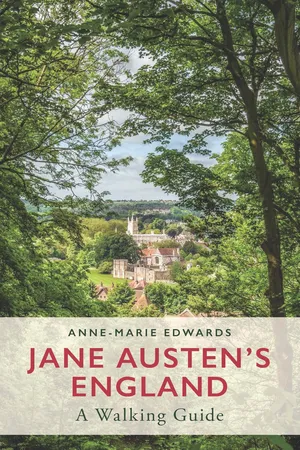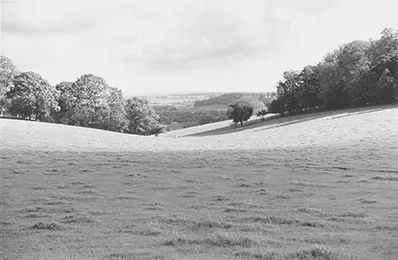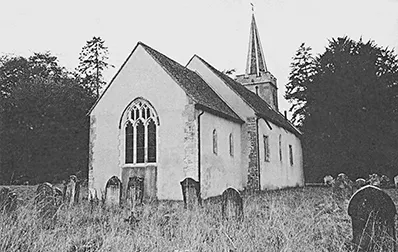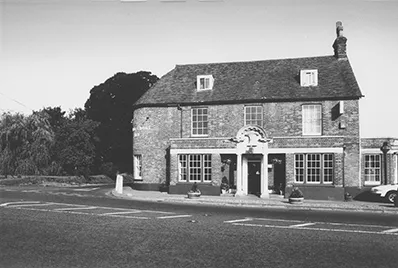
- 224 pages
- English
- ePUB (mobile friendly)
- Available on iOS & Android
eBook - ePub
About this book
An immersive journey through the landscapes that shaped Austen's life and fiction, explored through detailed walking tours.
This unique guide is the only book that lets you explore Jane Austen's England on foot, tracing the landscapes that shaped her life and fiction. With 15 circular walks through Hampshire, Kent, Bath, Devon, Lyme Regis and beyond, Anne-Marie Edwards reveals the real country houses, churches, and elegant cities Austen knew and the people who inspired her characters.
Visit Godmersham House, the model for Pemberley in Pride and Prejudice, and stand on Box Hill, where Emma's infamous picnic unfolded. Wander through Steventon's hedgerows, stroll the Cobb at Lyme Regis and explore Chawton Cottage, where Austen revised Sense and Sensibility and wrote Emma. Each walk is rich with literary insight, historical detail and vivid anecdotes drawn from Austen's letters.
First broadcast on the BBC and now updated with maps and illustrations, this remains the definitive walking guide to Austen's world. Whether you're a seasoned rambler or a devoted reader, Jane Austen's England offers a fresh, immersive way to experience the places behind the novels
This unique guide is the only book that lets you explore Jane Austen's England on foot, tracing the landscapes that shaped her life and fiction. With 15 circular walks through Hampshire, Kent, Bath, Devon, Lyme Regis and beyond, Anne-Marie Edwards reveals the real country houses, churches, and elegant cities Austen knew and the people who inspired her characters.
Visit Godmersham House, the model for Pemberley in Pride and Prejudice, and stand on Box Hill, where Emma's infamous picnic unfolded. Wander through Steventon's hedgerows, stroll the Cobb at Lyme Regis and explore Chawton Cottage, where Austen revised Sense and Sensibility and wrote Emma. Each walk is rich with literary insight, historical detail and vivid anecdotes drawn from Austen's letters.
First broadcast on the BBC and now updated with maps and illustrations, this remains the definitive walking guide to Austen's world. Whether you're a seasoned rambler or a devoted reader, Jane Austen's England offers a fresh, immersive way to experience the places behind the novels
Frequently asked questions
Yes, you can cancel anytime from the Subscription tab in your account settings on the Perlego website. Your subscription will stay active until the end of your current billing period. Learn how to cancel your subscription.
No, books cannot be downloaded as external files, such as PDFs, for use outside of Perlego. However, you can download books within the Perlego app for offline reading on mobile or tablet. Learn more here.
Perlego offers two plans: Essential and Complete
- Essential is ideal for learners and professionals who enjoy exploring a wide range of subjects. Access the Essential Library with 800,000+ trusted titles and best-sellers across business, personal growth, and the humanities. Includes unlimited reading time and Standard Read Aloud voice.
- Complete: Perfect for advanced learners and researchers needing full, unrestricted access. Unlock 1.4M+ books across hundreds of subjects, including academic and specialized titles. The Complete Plan also includes advanced features like Premium Read Aloud and Research Assistant.
We are an online textbook subscription service, where you can get access to an entire online library for less than the price of a single book per month. With over 1 million books across 1000+ topics, we’ve got you covered! Learn more here.
Look out for the read-aloud symbol on your next book to see if you can listen to it. The read-aloud tool reads text aloud for you, highlighting the text as it is being read. You can pause it, speed it up and slow it down. Learn more here.
Yes! You can use the Perlego app on both iOS or Android devices to read anytime, anywhere — even offline. Perfect for commutes or when you’re on the go.
Please note we cannot support devices running on iOS 13 and Android 7 or earlier. Learn more about using the app.
Please note we cannot support devices running on iOS 13 and Android 7 or earlier. Learn more about using the app.
Yes, you can access Jane Austen's England by Anne-Marie Edwards in PDF and/or ePUB format, as well as other popular books in Literature & Women Authors Literary Collections. We have over one million books available in our catalogue for you to explore.
Information
1
STEVENTON – HOME AND FAMILY
‘Last night the time came, and without a great deal of warning, everything was soon happily over. We have now another girl, a present plaything for her sister Cassy and a future companion. She is to be Jenny.’ So wrote the Reverend George Austen, rector of the north Hampshire village of Steventon, to his sister-in-law Mrs Walter, announcing the birth of his second daughter. His ‘Jenny’ was to become one of England's greatest novelists.
Born on 16 December 1775, Jane was the Austen's seventh child. Their eldest son, James, was ten. George, born the following year, suffered from fits and never lived at home. Then came Edward, the sensible, practical son, who was to be adopted by rich relatives and inherit large estates. Henry, born in 1771, handsome and witty, was considered by his father the most brilliant of his sons. He was Jane's favourite brother. Her sister Cassandra, to whom she was devoted, was born in 1773, and another brother, Frank, arrived the following year. After Jane, another son, Charles, was born in 1779. Jane called him ‘our own particular little brother’. Frank and Charles entered the Royal Navy and both rose to the rank of Admiral. As she grew up within the circle of this loving and talented family, Jane was able to develop the personal qualities which give her books their moral integrity, and to improve and polish her own natural gifts as a writer.
Jane spent the first twenty-five years of her life in Steventon. From an early age she was constantly writing, mostly comic pieces, to amuse her family. Like Walter Scott, she delighted in what his biographer calls ‘the queerness and the fun’. Among these early works which she collected into Volume the First, Volume the Second and Volume the Third, each solemnly dedicated to appropriate members of her family and her friends, is a clever burlesque of an over-sentimental romantic novel, called Love and Friendship. At one point the rigours endured by the two heroes, the harsh attitudes of parents and the influence of their own emotions provoke this delicious parody of excessive romanticism: ‘It was too pathetic for the feelings of Sophia and myself – we fainted alternately on the sofa!’ Jane also includes an amusing History of England which she describes as being by ‘a partial, prejudic'd and ignorant historian’. By the time she was twenty Jane was writing First Impressions, which she was to ‘lop and crop’ and later publish as Pride and Prejudice. The original versions of Sense and Sensibility and Northanger Abbey were also written at Steventon.
As Jane based her art on truthful and accurate observation of the life around her, she could, as she remarked, find plenty to write about in a small country village. And life in the rectory was never dull. Her mother, noted for her humour, passed this gift on to her children. She termed it their ‘sprack wit’. Jane sharpened this humour, based on good sense, into a brilliant weapon with which she fought sham of every kind. Her father, an ex-fellow of St John's College, was a fine scholar. He prepared James and Henry for Oxford and Jane shared in their reading. Among her favourite writers Jane included Johnson, Cowper, Goldsmith, Fielding and Richardson but she also delighted in the latest romances of Fanny Burney and the ‘Gothic’ horror tales of Mrs Radcliffe. She parodies some of these tales of lurid adventure, especially the hair-raising Mysteries of Udolpho, in Northanger Abbey. In Jane's story, the beautiful and accomplished heroine of the ‘Gothic’ novel becomes the rather ordinary Catherine Morland, delighted to overhear her parents comment: ‘Catherine grows quite a good-looking girl; she is almost pretty today.’ Catherine is humiliated to discover that her grave suspicions, fostered by her reading of melodramatic romances, about General Tilney's treatment of his wife at the Abbey, are groundless. But later, when the General exposes Catherine to the dangers of a long journey home, unaccompanied, and as far as he knows, penniless, Jane makes the point that real life can contain happenings as painful as any in Mrs Radcliffe's far-fetched dramas. Family discussions must often have found their way into Jane's novels as her characters talk about matters of the moment like the cult of the ‘picturesque’ in art and nature and the passion for landscape gardening as country gentlemen pursued the new natural look for their estates under the guidance of Repton and ‘Capability’ Brown.
Through her family, Jane was kept in touch with the great events of her time. One of their cousins, the enchanting and sophisticated Eliza, born in India and educated in France, visited Steventon. She returned to them with the shocking news that her husband had been guillotined in the French Revolution. In her letters, Jane expresses her concern for Sir John Moore's troops at Corunna; she had a first-hand account from Frank, who was in charge of their disembarkation in 1809. The effect of the long Napoleonic Wars on the civilian population lies behind most of her work. Naughty Lydia Bennet might have behaved better if she had not been dazzled by Wickham's red coat – the effect of billeting the militia on Meryton. Jane also mentions in her letters her care for the poor of her father's parish – ‘I have given a pair of worsted stockings to Mary Hutchins … a shift to Hannah Staples and a shawl to Betty Dawkins’ – and she would be aware of the appalling poverty and squalor that formed so marked a contrast with the elegance and refinement of her time. But the age of fully fledged romanticism was yet to come. Jane chose to portray the world she knew best; the comfortable, middle-class society of southern England.
Our first walk takes us to Steventon. We ramble in her footsteps along the paths and lanes close to the rectory and through the gentle, rolling countryside she presented so firmly in her novels. The rectory was pulled down soon after her death, but the twelfth-century church where she worshipped stands almost unchanged at the end of a nearby lane. This walk, about seven miles round, begins from the church, where there is room to park.
Steventon is about six miles west of Basingstoke. A pleasant approach to the village is through Whitchurch, Laverstoke and Overton, following the B3400 along the Test valley. About two-and-a-half miles from Overton, turn right for Steventon. Drive under the railway, and at the junction opposite the village hall, turn left. The road leads past the site of the rectory. Turn right following the sign to the church and park at the end of the lane. Approaching Steventon from the south, from the A30 or M3, take the turn for North Waltham, and then follow the lanes for about two miles to Steventon church.
From the church, walk back down the lane to see the site of the rectory. In the eighteenth century this was a rutted cart track which, in bad weather, Jane and Cassandra had to negotiate in their pattens: clog-like overshoes, raised several inches above the ground with iron rings beneath their wooden soles. But in fine weather they walked through the trees beside the road along a path they called ‘the Church Walk’, which led from their garden. As you approach the corner of the lane, you will see a raised terrace across the field on your left. This was the Austens’ ‘Wood Walk’, which ran west, forming the southern boundary of the home meadows, part of the glebe, or farm land, which belonged to the rectory. The Austens were keenly interested in the efficient running of their farm – Mrs Austen was proud of her dairy and the family had their own recipes for such delights as mead and currant wine – and like most of their contemporaries took pleasure in the laying-out and planting of their garden. Jane writes to Cassandra: ‘Our improvements have advanced very well: the bank along the elm walk is sloped down for the reception of thorns and lilacs; and it is settled that the other side of the path is to continue turf'd and planted with beech, ash and larch.’ Perhaps she recalls her own childhood pleasures when she tells us that Catherine Morland ‘loved nothing so well in the world as rolling down the green slope at the back of the house’.

Countryside near Steventon
The rectory stood on the corner, facing north. It was a well-built, two-storied house, with dormer attic windows. From the road, a short carriage drive ran to the trellised porch. The front door opened straight into the family parlour where Mrs Austen sat, making shirts and cravats and getting on with the mending in front of visitors, much to the embarrassment of Jane and Cassandra. The two girls shared a small bedroom and sitting room on the first floor, simply furnished with a chocolate-coloured carpet, a press with bookshelves above it, Jane's piano and writing desk with a sloping lid, Cassandra's drawing materials and an oval mirror. Jane's father had a bow-windowed study at the back, overlooking the garden, where he could sit surrounded by his library of over five hundred books. At St John's he had been known as ‘the handsome Proctor’ and Jane inherited his good looks. In his Memoir, her nephew Edward describes her as ‘very attractive; her figure was rather tall and slender … a clear brunette with a rich colour; she had full round cheeks, with mouth and nose small and well-formed, bright, hazel eyes, and brown hair forming natural curls round her face’.

Steventon church
Edward also comments on the happy atmosphere of their home: ‘Above all there was strong family affection.’ Jane mirrors this love of her family – particularly of her sister – in all her novels. In Sense and Sensibility, however foolish the over-sentimental Marianne may be, she never wavers in her devotion to her sister Elinor. Although Jane insists that the best marriages are based on mutual love and esteem – a startlingly modern view for her time – parental authority must always be respected. In Northanger Abbey General Tilney must give his blessing to the wedding of his son before the ceremony can take place.
In the field opposite the house there was a large barn where the Austens acted plays. Walk back up the lane to the church. An enormous yew stands sentinel beside this simple building with its slim Early English windows. When Jane's father, rector here for forty years, retired to Bath, James took over the living. You will see memorials to James, and his first wife Anne, in the chancel. The parish register records the marriage of a cousin of the Austens, Jane Cooper, and also some of our Jane's earliest work. THE BANNS OF MARRIAGE BETWEEN (then in her own hand) Henry Frederic Howard Fitzwilliam of London AND Jane Austen of Steventon WERE DULY PUBLISHED IN THIS CHURCH. Her father's reactions have not been recorded!
Opposite the church a new manor has been built on the site of a Victorian mansion, all that survived a disastrous fire. Jane knew well the elegant Elizabethan manor which stood nearby until 1970. The tenant-farmers were their friends, the Digweeds.
From the church, turn right along the lane for a few yards. Then follow the footpath sign pointing right over the field at the side of the church. Follow the path across the field and go over a stile. Bear half-right over the field ahead towards a pine wood. Before you come to the wood go through a small gate on your right. Keep straight ahead, with the wood on your left, to go through a gate and follow the clear way ahead. Go through another small gate and turn left to walk over open downland fields. The fields slope down to a shallow valley, and a little to the right, rising above the dip, you will see the squat tower of North Waltham church. Walk along the edge of the field, beside a belt of trees, and follow the fence round as it turns right. After about a hundred yards go through a gate on your left and walk down the field with the church now almost directly ahead. Go through a gate in the valley and walk up the green, with a tall hedge on your left, to a minor road. Turn right, down the road, towards North Waltham church.
Just past the church, turn left and walk down to the village green and pond, attractively surrounded by half-timbered, thatched cottages. Bear left up the lane signed ‘Dummer’. Continue for about half a mile to a footpath sign on the left set back a few yards from the turning. Take this beautiful wide way which runs through a fringe of tall trees over the downs. You are now walking along one of those special ‘hedgerows’ described by Edward in his Memoir as ‘the chief beauty of Steventon, an irregular border of copse-wood and timber, often wide enough to contain within it a winding footpath or cart track’. Jane sets a memorable scene in Persuasion in a hedgerow like this. The heroine Anne, sitting in a field out of sight, overhears a conversation between her former lover, Captain Wentworth, and her rival, Louisa, who are walking down the central path unaware of her presence. The path leads down to a cross track. Bear right following the footpath sign, with the wood on your right, and walk down the field ahead. Cross a stile, to emerge on the main A30 road by a footpath sign.
Turn right and walk the short distance to the Sun Inn. Continue past the Sun Inn on your right for a few yards, cross the main road and turn left and follow the road signposted to Dummer (which soon becomes a pleasant lane). Pass a road junction and bear left, past the pond until you see the entrance to Dummer church on the right. This twelfth-century church is one of the highlights of the walk. It is full of what John Betjeman called ‘rustic cottagey interest’ with its seventeenth-century gallery supported by massive oak beams, and rare medieval rood canopy. To the right of the entrance a narrow stair leads to the bellringers’ loft and the gallery. The timbers are so thick that it is thought they may have been salvaged from a ship or even be part of what was once a Saxon wooden church.

‘The chief beauty of Steventon’ – a double hedgerow
The white manor house, almost behind the church, was well known to Jane Austen as the home of the Terry family. Although, in one of her letters, she describes them as ‘noisy’ she also records dancing five times with Stephen Terry at a county ball. Stephen, just a year older than Jane, tells many stories of country life in his fascinating Diaries of Dummer. One foggy day, he and a friend lost themselves while shooting woodcock in the New Forest. They were rescued by their resourceful wives who caused the bells of Brockenhurst church to be rung! Stephen's son, Seymour, married Jane's cousin, Georgie Lefroy.
From the church, turn left and walk back through the village to the junction with the Candover road. Turn left and follow this road through attractive rolling countryside, to a T junction. Turn right for North Waltham. Walk under the motorway and cross the A30 to the Wheatsheaf Inn. This hotel was an important posting-house during the days of the stage coach. Jane walked here to collect the family mail, from North Waltham, down the road to the left of the Wheatsheaf called Popham Lane. As the recipient, she would pay for their letters, which, on 11 February 1801, contained one from Charles ‘written last Saturday from off the Start and conveyed to Popham Lane by Captain Boyle in his way to Midgham’.

The Wheatsheaf Inn on the corner of Popham Lane
Walk up Popham Lane to North Waltham. Turn left, passing the pond on your right, then retrace our route to the church. Turn right by the church along the way we came, left at the footpath sign over the fields, then through the wood to Steventon church.
Walk in Brief
From Steventon church walk down the lane to see site of rectory. Return and follow footpath sign on left just before the church. Follow path across two fields, bearing half-right to a pine wood. ...
Table of contents
- Front Cover
- Title Page
- Copyright
- Contents
- Illustrations
- Acknowledgements
- A Note on the Routes
- Calendar
- Introduction
- 1. Steventon – Home and Family
- 2. Steventon – Visiting Friends and Seeing ‘The Neighbourhood’
- 3. In the Hampshire Highlands – Staying with the Lloyds at Ibthorpe
- 4. With Edward in Kent – Goodnestone and Rowling
- 5. Godmersham
- 6. Jane Visits Bath
- 7. Residence in Bath
- 8. Holidays in Devon
- 9. Lyme Regis – ‘Summers by the Sea’
- 10. Southampton – Jane and the Navy
- 11. ‘Our Chawton Home’
- 12. Walking to Alton, Wyards Farm and Chawton Park
- 13. Great Bookham and an ‘Exploring Party’ to Box Hill
- 14. Jane in London
- 15. Winchester – Jane’s Last Journey
- Walking in England
- Book List